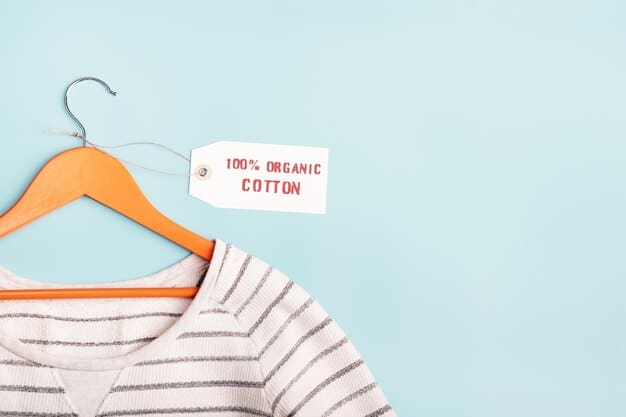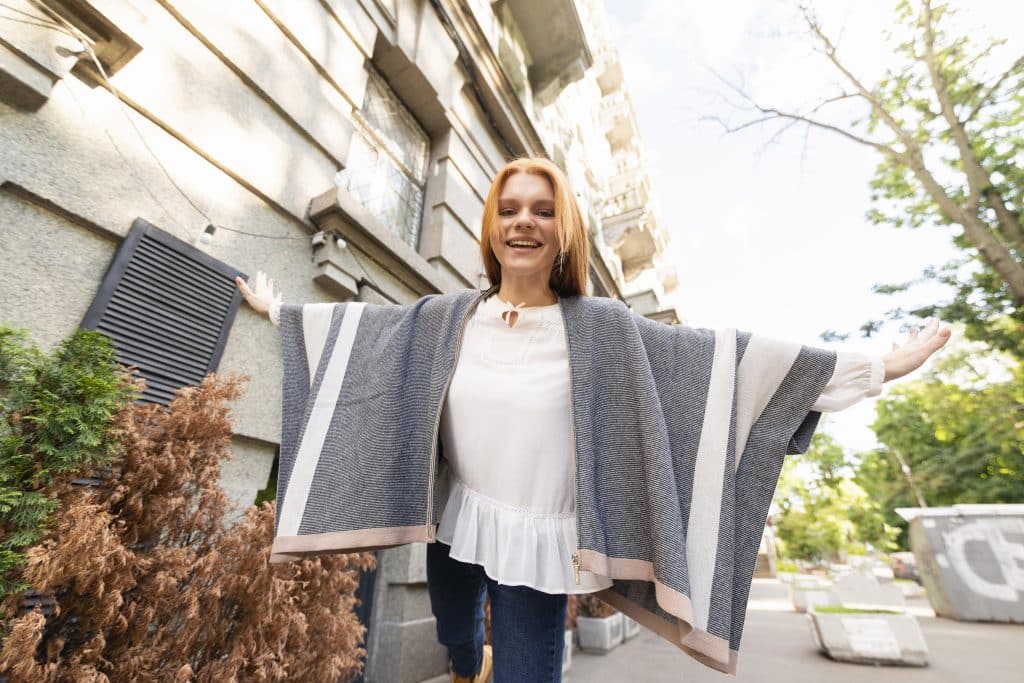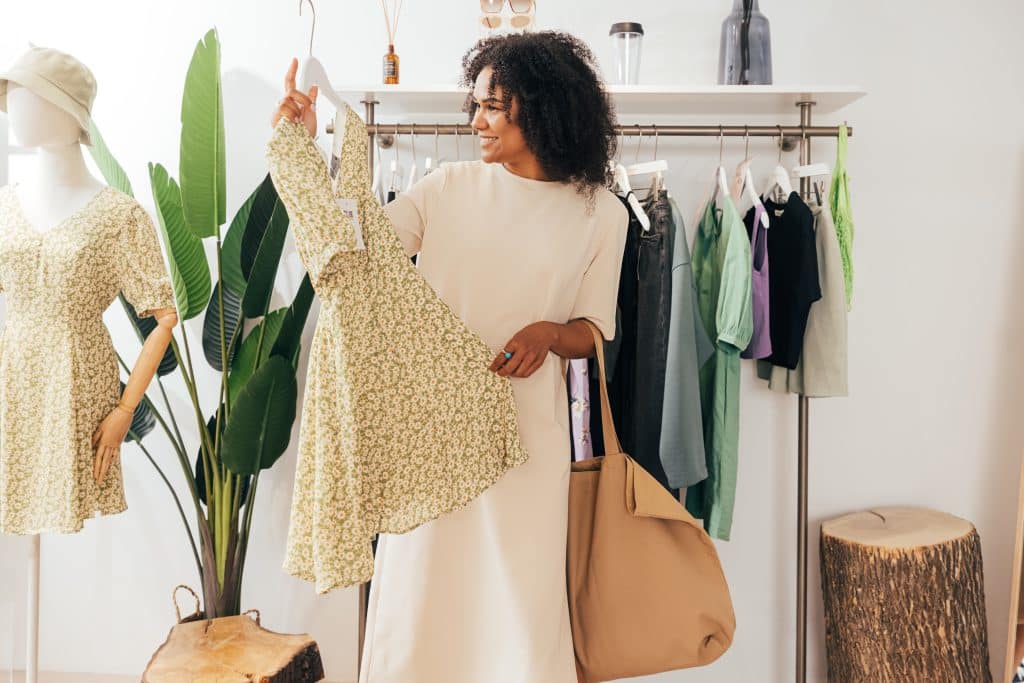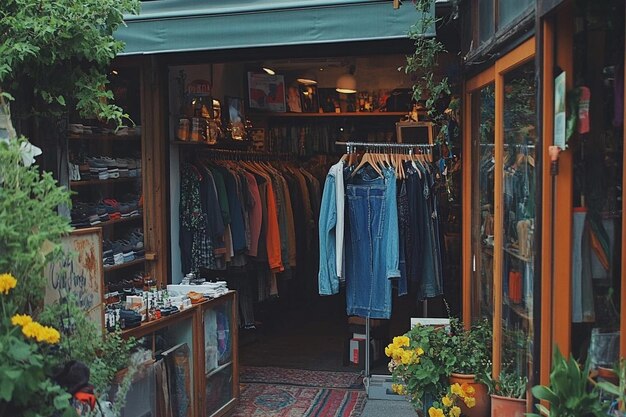The rise of sustainable fashion: Eco-friendly clothing trends in the US

Anúncios
Sustainable fashion is revolutionizing the US apparel scene, driven by a new generation of consumers demanding style with conscience.
As awareness of fast fashion’s environmental and ethical costs grows, brands are reimagining how clothes are made, embracing eco-friendly materials, fair labor, and innovation to redefine what it means to dress responsibly.
Understanding the shift towards sustainable fashion
The fashion landscape in the US is undergoing a profound transformation, moving away from a disposable culture toward one that values longevity, ethical production, and environmental mindfulness.
This paradigm shift is not merely a passing fad, but a deep-seated movement, driven by increasingly informed consumers and a new generation of designers and brands committed to making a difference.
The awareness of climate change, resource depletion, and social injustices within supply chains has reached a critical mass, compelling the industry to re-evaluate its modus operandi.
Traditionally, fashion has been built on a linear model: produce, consume, discard.
This approach, driven by fast trends and cheap overseas production, has caused severe environmental harm, including textile waste, water pollution, and high carbon emissions.
The social cost is equally staggering, with ongoing concerns about fair wages, safe working conditions, and child labor in many production hubs.
As consumers become more educated on these issues, their purchasing power is increasingly directed toward brands that offer transparency and genuinely sustainable alternatives.
This evolution in consumer behavior marks the foundation of sustainable fashion, where values, ethics, and aesthetics converge to shape the future of style in the United States.

Defining eco-friendly clothing
Eco-friendly clothing refers to garments produced using methods and materials that minimize environmental harm and uphold ethical standards.
It’s a broad category encompassing various practices and certifications, with one primary goal: to reduce the ecological footprint from raw material extraction to manufacturing, distribution, use, and eventual disposal.
Elements of eco-friendly clothing
- Organic materials: Fibers like organic cotton, linen, and hemp are grown without harmful pesticides, synthetic fertilizers, or GMOs.
- Recycled materials: Utilizing post-consumer waste, such as recycled polyester (from plastic bottles) or upcycled fabrics, to create new garments.
- Low-impact dyes: Employing natural dyes or synthetic dyes with significantly reduced environmental toxicity and water consumption.
- Resource conservation: Adopting practices that minimize water, energy, and chemical usage throughout production.
These definitions are crucial because they help consumers navigate a market increasingly flooded with “greenwashing”, misleading claims about environmental friendliness.
True eco-friendly brands often provide certifications and detailed information about their supply chains, ensuring that their commitment to sustainable fashion goes beyond marketing.
The growing clarity around what defines eco-friendly clothing empowers consumers to make informed, responsible choices that align with both their values and environmental consciousness.
Drivers of the trend in the US
Several factors converge to propel sustainable fashion into the mainstream in the United States.
Consumer demand is perhaps the most powerful force behind this shift.
Surveys consistently show that younger generations, particularly Gen Z and Millennials, are willing to pay more for ethically produced goods.
Social media amplifies this awareness, allowing consumers to share information, and criticism, about brand practices in real time.
This digital transparency fosters a community of conscious consumers that expects accountability and honesty from brands.
Moreover, regulatory pressures, though still emerging in the US compared to Europe, are beginning to encourage brands to adopt more sustainable practices.
Technological advancements also play a vital role, enabling innovation in material science, circular production models, and efficient manufacturing processes.
High-profile collaborations between mainstream brands and sustainability advocates, along with celebrity endorsements, are further normalizing eco-friendly apparel and expanding its appeal beyond niche markets.
The movement toward sustainable fashion is complex, reflecting a shift in values and priorities across the entire supply chain.
It challenges the status quo and invites innovation, collaboration, and a fundamental rethinking of what fashion truly means in the 21st century.
This initial push sets the stage for deeper exploration into the specific materials, technologies, and challenges that define this growing trend.
![]()
Sustainable materials and innovations driving growth
The heart of sustainable fashion lies in its innovative use of materials and processes.
Brands are constantly exploring new ways to create clothing that is beautiful, durable, and functional while minimizing environmental harm.
This innovation involves both a return to traditional methods and the development of new textiles from unexpected sources.
The focus is clear: reduce reliance on virgin synthetic materials, which are often petroleum-based, and promote renewable, regenerative, or recycled resources.
The journey from raw material to finished garment is complex, and sustainability must be considered at every step.
This involves not only the source of the fiber but also the processing, dyeing, and finishing methods.
Innovations aren’t just about new materials, they’re about optimizing existing ones to be more efficient and less polluting.
Consumers are becoming more discerning, looking beyond vague “eco-friendly” claims to understand the specifics of what makes a material truly sustainable.
This awareness is driving a new era of material science within sustainable fashion, where creativity meets responsibility.
Beyond organic cotton: Emerging eco-fibers
While organic cotton remains a cornerstone of sustainable fashion, the industry is witnessing a surge of innovation and investment in diverse eco-fibers.
These new materials address different environmental concerns, from water conservation to biodegradability, offering a wider palette for designers and brands.
- Hemp and Linen: Ancient fibers making a strong comeback for their minimal water use, low pesticide needs, and soil-rejuvenating qualities. They’re also incredibly durable.
- Lyocell (Tencel™): A regenerated cellulosic fiber made from wood pulp in a closed-loop system, recycling chemicals and water efficiently. It’s praised for its softness, strength, and breathability.
- Piñatex: A vegan, sustainable leather alternative made from pineapple leaf fibers, utilizing agricultural waste and offering a unique texture.
- Recycled PET (rPET): Polyester made from recycled plastic bottles. Though not biodegradable, it diverts plastic from landfills and reduces the need for new fossil fuels.
- Mycelium-based materials: Created from fungi, these innovative materials are biodegradable alternatives to leather and foam, showing immense promise for future applications.
These emerging fibers not only reduce environmental impact but also challenge designers to think more creatively about texture, drape, and performance.
As technology advances, their cost and availability are improving, making them more accessible to both boutique and mainstream brands.
The result is a more diverse, resilient, and exciting era for sustainable fashion.
Circular economy principles in fashion
The concept of a circular economy is rapidly gaining traction in the fashion world, offering a revolutionary alternative to the linear “take-make-dispose” model that has dominated for decades.
In a circular system, materials are kept in use for as long as possible, their value is maximized during use, and products and materials are recovered and regenerated at the end of their life cycle.
This approach aligns perfectly with the core mission of sustainable fashion, aiming to close the loop on waste and overconsumption.
Designing for durability, repairability, and recyclability lies at the heart of this model. To achieve this, brands are exploring various circular strategies that redefine how clothing is created and consumed:
- Design for longevity: Crafting timeless, high-quality garments that last longer and reduce the need for frequent replacements.
- Repair and resale programs: Encouraging customers to repair their clothes or participate in resale platforms, extending a garment’s lifespan.
- Material recycling: Developing technologies to break down textiles into their original fibers for remanufacturing, creating a closed-loop system.
- Rental and subscription models: Promoting shared access to fashion through rental services or subscription-based wardrobes, reducing individual consumption.
- Implementing circular economy principles requires significant investment in research, development, and supply chain collaboration.
However, the long-term rewards, reduced waste, lower resource usage, and new business models, are undeniable.
For brands, circularity offers environmental progress, stronger customer loyalty, and future-proof operations.

Advancements in production technologies
Technological innovations are revolutionizing how clothing is made, playing a pivotal role in advancing sustainable fashion.
These breakthroughs span from more efficient manufacturing processes to digital tools that reduce waste, improve transparency, and enhance overall production efficiency.
Key technological innovations
- 3D printing and additive manufacturing: Allow for on-demand production and complex designs with minimal material waste, eliminating the need for traditional pattern cutting.
- Waterless dyeing techniques: Innovations like air dyeing and CO₂ dyeing drastically reduce water consumption and eliminate toxic chemicals, addressing one of fashion’s most polluting processes.
- Digital design and prototyping: Using software to create virtual samples reduces the need for physical samples, saving materials, time, and shipping emissions.
- AI and data analytics: Artificial intelligence optimizes supply chains, forecasts demand accurately, and helps reduce overproduction, a major source of waste.
These technological advances not only make production more sustainable but often increase efficiency and generate long-term cost savings.
As these innovations become more accessible, their adoption across the fashion industry is expected to accelerate, further cementing sustainable fashion practices in mainstream production.
The constant innovation in materials and production methods reflects the industry’s commitment to sustainability.
These advancements are about more than just mitigating environmental harm; they also aim to create a resilient, resource-efficient, and ethical future for clothing.
As consumers continue to demand transparency and responsibility, the pace of innovation is likely to intensify, bringing groundbreaking solutions to the forefront of sustainable fashion.
Consumer behavior and market impact in the US
The growing awareness among consumers is fundamentally reshaping the US fashion market.
Today, purchasing decisions are no longer driven solely by style or price; ethical and environmental considerations increasingly influence buying behavior.
This shift is creating significant opportunities for brands that genuinely embrace sustainable fashion, while pressuring traditional players to adapt or risk being left behind.
Consumers, especially younger demographics, are becoming more educated about the fashion industry’s impact.
Social media, documentaries, and news coverage have exposed the dark side of fast fashion, prompting many to seek responsible alternatives.
This conscious approach is not just about avoiding harm; it is about aligning personal values with consumption habits, fostering a more intentional wardrobe.
The desire for transparency and authenticity from brands has now become a central part of the consumer decision-making process, reinforcing the growth of sustainable fashion in the US.
The conscientious consumer: Who they are and what they seek
The “conscientious consumer” is not a single group but shares common traits: a commitment to responsible consumption and ethical values.
- Younger demographics: Millennials and Gen Z are at the forefront, having grown up aware of climate change and environmental crises.
- Digitally native: They research brands online, read reviews, and verify ethical practices.
- Value-driven: Purchasing choices are influenced by a brand’s commitment to social justice, environmental protection, and fair labor.
- Transparency-seeking: They want to know where and how clothes are made, the materials used, and the impact of supply chains.
Key elements these consumers look for include:
- Certifications: Labels like GOTS, Fair Trade Certified, or OEKO-TEX Standard 100 offer reassurance.
- Brand storytelling: Authentic communication about a brand’s sustainability mission.
- Quality and longevity: Durable, well-made items that counteract the “wear-once-discard” mentality.
- Innovative materials: Interest in new eco-fibers and recycled content.
While price remains a consideration, many conscientious consumers are willing to pay a premium for items that align with their values, viewing it as an investment in a sustainable future.
The rise of secondhand and rental markets
Beyond new clothing, the US is witnessing significant growth in alternative consumption models, such as secondhand and rental markets.
These sectors epitomize circular fashion, extending the life cycle of garments and reducing textile waste.
- Secondhand (Thrift and Resale): Platforms like ThredUp, Poshmark, and The RealReal democratize access to pre-owned clothing. The stigma associated with secondhand is diminishing, replaced by a sense of discovery and sustainability.
- Rental Services: Companies like Rent the Runway provide clothing rentals for special occasions or everyday wear, promoting shared usage and reducing individual consumption.
These models appeal not only to eco-conscious consumers but also to those seeking cost-effective ways to update wardrobes or experiment with new styles.
Their growth reflects a broader cultural shift: valuing access over ownership and embracing a more resourceful approach to sustainable fashion.
Challenges and opportunities for mainstream brands
The shift toward sustainable fashion presents both significant challenges and enormous opportunities for mainstream US brands.
The pressure to adapt is intense, but the potential rewards for those who get it right are equally substantial.
Challenges
- Supply chain complexity: Retooling global supply chains to incorporate sustainable practices is a monumental task.
- Cost implications: Sustainable materials and ethical labor often come at a higher price, potentially affecting profit margins or requiring higher consumer prices.
- Greenwashing risk: Brands can face reputational damage if claims are not backed by evidence or full transparency.
- Consumer education: Bridging the gap between consumer intent and actual purchasing behavior remains a key challenge, especially concerning price sensitivity.
Opportunities
- Market differentiation: Brands committed to sustainable fashion can stand out in a crowded market and attract eco-conscious consumers.
- Brand loyalty: Conscientious consumers exhibit higher loyalty to brands that align with their values.
- Innovation and efficiency: Investing in sustainable practices often drives process improvements and long-term cost savings.
- Positive brand image: Enhanced public perception attracts talent, investors, and loyal customers who value ethical conduct.
Successful brands are investing in certifications, collaborating with sustainable suppliers, launching eco-friendly collections, and communicating their sustainability journey.
The market impact of sustainable fashion is undeniable. It is forcing a re-evaluation of business models and pushing the industry toward a more responsible future.
Government policies and industry certifications
While consumer demand is a powerful driver of sustainable fashion, clear government policies and robust industry certifications provide the framework needed for widespread adoption and accountability.
In the US, the regulatory landscape is still evolving compared to Europe, but distinct movements and standards are gaining prominence.
These guidelines are essential to prevent greenwashing, foster genuine change, and build consumer trust.
Effective policies can incentivize sustainable practices through tax breaks, grants, or regulations on waste.
Certifications, on the other hand, offer a standardized way for brands to prove their claims, allowing consumers to make informed decisions without deep research into every product’s supply chain.
Together, policies and certifications create a level playing field and encourage continuous improvement within the fashion industry.
Current US policies and legislative efforts
Despite the progress driven by consumer demand, the US has historically lagged behind the EU in comprehensive federal legislation on textile sustainability.
However, several notable initiatives exist:
- California’s Leadership: States like California pioneer legislation on extended producer responsibility (EPR), holding brands accountable for the end-of-life of their products.
- Recycling Infrastructure: Federal and state grants occasionally support textile recycling infrastructure, addressing the massive volume of textile waste generated annually.
- Truth in Advertising: The Federal Trade Commission (FTC) enforces rules against deceptive marketing, which can include misleading eco-friendly fashion claims.
- Proposed Bills: Ongoing discussions aim to regulate chemical usage, supply chain transparency, and fair labor practices, though progress is gradual.
The lack of unified federal legislation means brands must navigate a patchwork of state-specific rules, yet public pressure and global standards suggest more comprehensive regulations are likely.
Important industry certifications and standards
In the absence of broad federal oversight, industry certifications are critical to validate sustainable practices.
Recognized accreditations provide credibility and consumer assurance:
- Global Organic Textile Standard (GOTS): Covers organic textiles from fiber to distribution and ensures social criteria are met.
- Fair Trade Certified: Focuses on social justice, fair wages, safe working conditions, and community development.
- OEKO-TEX Standard 100: Certifies textiles and accessories are free from harmful substances, ensuring consumer safety.
- Bluesign®: Addresses the entire textile production process, promoting resource efficiency, minimal environmental impact, and worker safety.
- Recycled Claim Standard (RCS) / Global Recycle Standard (GRS): Tracks the amount of recycled material in products and ensures social and environmental compliance.
For brands, achieving certifications requires rigorous audits and ongoing compliance.
For consumers, these labels provide a quick, reliable indicator of a product’s sustainable fashion credentials.

The role of transparency and traceability
Transparency and traceability are now essential pillars of sustainable fashion. Consumers and advocacy groups want to know exactly where and how garments are made, including:
- Source of raw materials: Origins of cotton, wool, or synthetic fibers.
- Manufacturing locations: Factories where cutting, sewing, and finishing occur.
- Labor conditions: Verification of fair wages, safe environments, and the absence of forced or child labor.
- Environmental footprint: Data on water, energy, and chemical usage at each stage.
Emerging technologies, such as blockchain, provide immutable records of a product’s journey, enhancing traceability.
Brands embracing transparency gain a competitive edge, building trust, which is increasingly valuable in today’s market.
Challenges and the path forward for sustainability
Despite the undeniable momentum of sustainable fashion, the path toward a fully eco-conscious industry is complex.
Transforming a global, multi-trillion-dollar industry built on speed and disposability requires addressing both economic and behavioral challenges.
Recognizing these hurdles is the first step toward innovative solutions that drive lasting change.
The industry faces a central dilemma: how to grow responsibly while meeting consumer demand and remaining profitable.
This often involves re-evaluating business models, investing in new technologies, and advocating for supportive policies.
The journey is non-linear, requiring continuous effort, collaboration, and adaptation to environmental and social pressures.
Scaling sustainable practices: Hurdles and solutions
Scaling sustainable fashion from niche brands to mainstream adoption presents unique challenges.
What works for small labels can be difficult to implement for large corporations with global supply chains.
Scaling sustainable fashion faces key challenges, each with solutions. Cost is a major concern, as sustainable materials and ethical production are often pricier.
Solutions include government incentives, R&D investment to reduce costs, and educating consumers on the value of sustainable products. Supply chain complexity is another hurdle.
Tracing materials and ensuring ethical labor across multiple tiers can be addressed with traceability tools like blockchain, industry collaboration, and direct supplier relationships.
Infrastructure gaps in recycling, repair, and circular production remain. Solutions include public-private partnerships, efficient recycling technologies, and take-back programs.
These strategies pave the way for scalable, sustainable practices across the fashion industry.
Scaling requires systemic change, demanding cooperation between brands, suppliers, governments, and consumers to build a resilient sustainable ecosystem.
Addressing greenwashing and building trust
As sustainable fashion gains popularity, the risk of greenwashing increases, where brands make misleading environmental claims. This can erode consumer trust and undermine genuine efforts.
Strategies to combat greenwashing include:
- Regulatory oversight: Stronger enforcement by bodies like the FTC and clear guidelines on sustainable claims.
- Third-party verification: Encouraging independent certifications to validate claims.
- Transparency and data sharing: Publicly sharing environmental and social impact data, not just marketing statements.
- Media and consumer vigilance: An informed public and critical media expose misleading practices.
Building genuine trust requires consistent, verifiable action.
Brands truly committed to sustainable fashion are transparent about challenges and progress rather than claiming perfection.
The role of consumer education and advocacy
While brands and policymakers play crucial roles, sustained change depends on informed consumer choices and advocacy.
- Access to information: Provide clear, accessible insights on materials, practices, and ethical considerations.
- Influencer impact: Leverage social media influencers and thought leaders to highlight conscious consumption.
- Advocacy groups: Support organizations pushing for systemic change in the fashion industry.
- Behavioral shifts: Encourage behaviors like buying less but better, repairing clothes, and participating in secondhand markets.
Educating consumers goes beyond telling them what to buy; it empowers them to understand the impact of their choices and demand better from the industry.
A sustainable future
The path forward is complex but promising.
With continued innovation, robust policy frameworks, and persistent consumer engagement, sustainable fashion can move from trend to norm.
The industry is gradually shifting toward a more ethical, transparent, and eco-conscious future, where fashion meets responsibility without compromising style or functionality.
For brands, consumers, and policymakers alike, the message is clear: sustainable fashion is not just a preference, it is the future of the apparel industry.
| Key Aspect | Brief Description |
|---|---|
| 🌱 Eco-Friendly Materials | Shift to organic, recycled, and innovative fibers like hemp, linen, and mycelium for reduced impact. |
| ♻️ Circular Economy | Focus on design for longevity, repair, resale, and advanced recycling to minimize waste. |
| 🛍️ Conscious Consumers | Growing demand for transparency, ethical production, and certified sustainable products drives market changes. |
| 🤝 Industry Challenges | Overcoming costs, supply chain complexity, and greenwashing requires collaboration and innovation. |
Frequently Asked Questions (FAQ) about Sustainable Fashion in the US
Sustainable fashion refers to clothing produced in an environmentally and socio-economically responsible manner. It’s trending in the US due to increased consumer awareness of fast fashion’s negative impacts, growing environmental concerns, and a desire for transparency and ethical practices from brands, particularly among younger generations.
Eco-friendly materials include organic cotton, hemp, linen, recycled polyester (rPET), Lyocell (Tencel™), and innovative alternatives like Pinatex (pineapple leaf fibers) and mycelium-based materials. These are chosen for their reduced environmental footprint, lower water/chemical usage, and biodegradability compared to conventional options.
Look for third-party certifications like GOTS (Global Organic Textile Standard), Fair Trade Certified, OEKO-TEX Standard 100, and Bluesign®. Genuine brands also offer transparency about their supply chains, production processes, and environmental impact data. Be wary of vague “green” claims without verifiable evidence.
Secondhand and rental markets are crucial for sustainable fashion as they extend the lifespan of garments, reducing textile waste and the need for new production. They promote a circular economy by keeping clothes in use longer, reducing environmental impact, and offering consumers more sustainable ways to refresh their wardrobes.
Key challenges include higher production costs for sustainable materials and ethical labor, the complexity of managing global sustainable supply chains, limited infrastructure for textile recycling, and the pervasive issue of “greenwashing.” Overcoming these requires significant investment, technological innovation, and strong regulatory frameworks.





